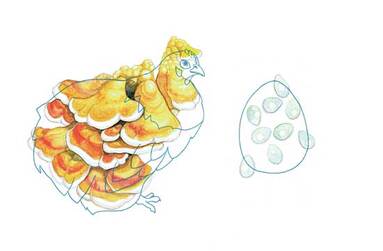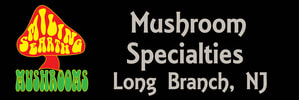 review originally published in the NJMA Newsletter, Volume 50-1 January-February 2020 DIY Mushroom Cultivation: Growing Mushrooms at Home for Food, Medicine and Soil By Willoughby Arevalo Published by New Society Publishers (June, 2019). (184 pages) ISBN 9780865718951 When the opportunity to review this book for the NJMA newsletter came along I jumped on it! Despite my history with cultivation of mushrooms, I've never actually read a cultivation book. I've learned everything by watching and doing. I attended a class taught by the author, Robert Rogers and Olga Tsogas of Smugtown Mushrooms which was quite intimate and intense, about 20 strangers in a house in the woods for 3 days, eating and learning together. Willoughby was knowledgeable and entertaining, but researching more after the class I found no website, Facebook or other way to easily get more from him, until this book.  This book was informative and thorough. The artwork and diagrams were helpful and enhanced my grasp on the topics. Some of his views come through which I thought were refreshing such as shifting our way of speaking from old terms such as "colonization" a rather European/human term, to "myceliation". And gasteroid "Do you know of any other beings that make their reproductive units in stomach-like structures? I think we should call these species the uteroid fungi." These ways of thinking carry over into his cultivation methods as well. Chapter 1 covers mushroom basics including taxonomy and life cycle. Chapters 2 and 3 discuss the many details of designing your business, workspaces, tools, lab setup. Options for growing spaces range from hanging a bag in your shower to larger climate controlled fruiting rooms, the many details of which are discussed. Chapter 4 covers sanitation, the contamination that inevitable will occur, how mushrooms are made to deal with it and how we should deal with it. I laughed at a method for dealing with the insects- vacuuming them up from the air, which works but looks quite silly if you don't know what is going on! Chapter 5 is about starting and maintaining cultures from spore prints to liquid syringes, agar and cardboard all with step by step instructions. Chapter 6 covers grain spawn and the many methods of sterilization and transfer. Chapter 7 is all about the fruiting and the many vessels and substrate options that exist for fruiting. Chapter 8 covers outdoor growing and what to do with your spent blocks, which often end up outside. Chapter 9 is the final product and how to harvest, process, cook, use for medicine, mycoremediate and different art you could create. Appendix 1 has basic but nice species profiles covering mushroom descriptions, ecology, methods of cultivation, difficulty level and yield, growth parameters, medicinal and nutritional properties, culinary value and use for 12 of the most common cultivated food and medicinal mushrooms. Appendix 2 has a lengthy list of resources for spores, supplies, further reading, stores, education, and gatherings which I thought covered everything. I think this is a great book for a beginner or someone looking to grow some mushrooms as a hobby or small scale production. As a more experienced grower I was excited to learn a few new tricks and methods that I've never ventured into like Liquid Cultures and different sterilization techniques. Some of them I'd never bother with personally, unless I'm a survivor of the apocalypse, but I can appreciate that anyone, anywhere can attempt to grow mushrooms to feed themselves. He covers options for spawn expansion for people who can't obtain or afford to spare the simple grains, the usual medium for spawn expansion, to use to grow a crop through more advanced lab techniques requiring sometimes expensive equipment. He encourages using various containers that could be found in the trash and/or recycled for growing in, something once again accessible to most everyone. Anyone can use this book to start growing mushrooms from those with incredibly limited resources, to urban settings and very small spaces, to farms with large amounts of land and natural resources. He touches on many ideas of eco-consciousness like using invasive plant material for substrates and other waste for substrate. The problem so many of us growers battle, the horrible single use plastics is mentioned and alternatives offered. There is a fun section encouraging us to think like a mushroom with 12 or so actions to follow.
0 Comments
Your comment will be posted after it is approved.
Leave a Reply. |
AuthorWe're a couple of mushroom fans. We grow mushrooms. We cook mushrooms. We create mushroom snacks. We forage mushrooms. We sell mushrooms to chefs. We sell mushrooms to the public. We study mushrooms. Amateur mycologists. Archives
December 2022
Categories
All
|

 RSS Feed
RSS Feed